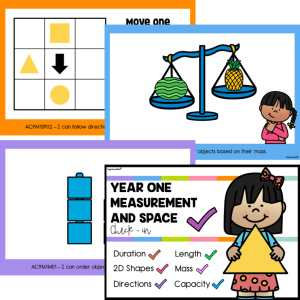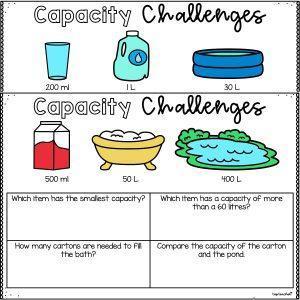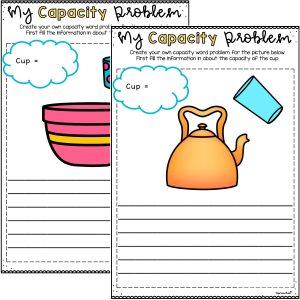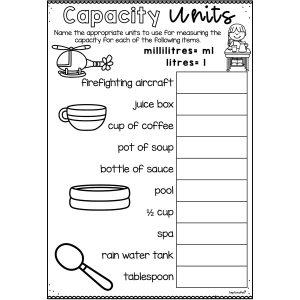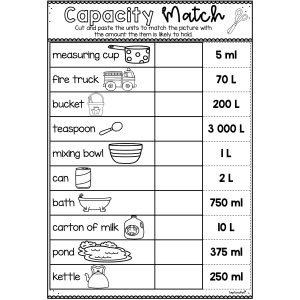Cup-acity Worksheets

Description
Make capacity concepts hands-on, practical, and fun with our Cup-acity Worksheets – a collection of engaging tasks designed to deepen student understanding through playful experimentation and real-world investigation. These worksheet-based activities provide rich opportunities for students to explore the concept of capacity using informal units and common classroom materials.
This resource includes three unique activities that encourage active measurement, prediction, and comparison. From challenging perceptions about what holds more to counting how many scoops it takes to fill a container, each task has been thoughtfully created to guide students through essential early measurement understandings.
Use these worksheets as a perfect supplement to your measurement unit or as a maths rotation task that allows for practical exploration. Students will get to pour, estimate, compare, reflect, and most importantly – think like mathematicians!
Key Learning Outcomes:
- ✅ Develop a practical understanding of capacity through informal measurements
- ✅ Make comparisons between different containers using everyday objects
- ✅ Use estimation and observation to evaluate volume and capacity
- ✅ Reflect on and record findings using drawing and written responses
- ✅ Challenge misconceptions by observing non-obvious differences in capacity
What’s Included:
- Three differentiated capacity investigation worksheets:
- - Which Cup Holds the Most? (visual perception vs. actual capacity)
- - Measuring with Different Materials (using informal units)
- - How Many Cups? (estimation and measurement practice)
- Spaces for drawing, recording, and reflecting included in each task
Materials Needed:
- Different sized cups or containers (short and wide, tall and thin)
- Water and a pouring container (e.g., jug or measuring cup)
- Informal units like pom poms, beans, buttons, cubes or marbles
- Plastic tubs or trays to catch spills and keep things tidy
- Pencils, crayons, or markers for drawing and recording
- Paper towels or cloths for quick cleanup
How to Use:
- Introduce the idea of capacity with real-life examples and discussion
- Demonstrate the first task – “Which Cup Holds More?” – as a whole class
- Set up materials at stations and allow students to complete investigations
- Encourage students to talk through what they see and what surprised them
- Use the worksheets for students to draw, label, and reflect on each activity
Ideas for Classroom Use:
- 💡 Use in rotations as part of a hands-on measurement unit
- 💡 Set up as science-style experiments with student-led inquiry and prediction
- 💡 Send one of the worksheets home for a real-life kitchen measuring activity
- 💡 Combine with a class chart – record everyone's findings and compare data!
- 💡 Pair with physical demonstrations using large transparent containers to show overflow and capacity in action
Top Teacher Tips:
- 💛 Laminate a few copies of the worksheets for use with whiteboard markers at your measurement station
- 💛 Use non-spill containers or tray setups to keep things manageable and mess-free
- 💛 Model key vocabulary like “more than,” “less than,” and “same as” to build maths talk
- 💛 Choose containers with subtle volume differences to really challenge students’ thinking
Cup-acity Worksheets are a fun and practical way to bring measurement to life – giving your students meaningful experience with comparison, estimation and accurate observation as they explore the wonderful world of capacity!
Additional information
| Australian Curriculum Code | AC9M1M01, AC9M1M02, AC9M2M01, AC9MFM01 |
|---|---|
| File Format |
Australian Curriculum V9
F - 6
Lorem ipsum dolor sit amet, consectetur adipiscing elit.
Lorem ipsum dolor sit amet, consectetur adipiscing elit.
Lorem ipsum/ Lorem ipsum/ Lorem ipsum
Lorem ipsum dolor sit amet, consectetur adipiscing elit.
Lorem ipsum dolor sit amet, consectetur adipiscing elit.
Lorem ipsum/ Lorem ipsum/ Lorem ipsum
Lorem ipsum dolor sit amet, consectetur adipiscing elit.
Lorem ipsum dolor sit amet, consectetur adipiscing elit.
Lorem ipsum/ Lorem ipsum/ Lorem ipsum
Lorem ipsum dolor sit amet, consectetur adipiscing elit.
Lorem ipsum dolor sit amet, consectetur adipiscing elit.
Lorem ipsum/ Lorem ipsum/ Lorem ipsum
Lorem ipsum dolor sit amet, consectetur adipiscing elit.
Lorem ipsum dolor sit amet, consectetur adipiscing elit.
Lorem ipsum/ Lorem ipsum/ Lorem ipsum

